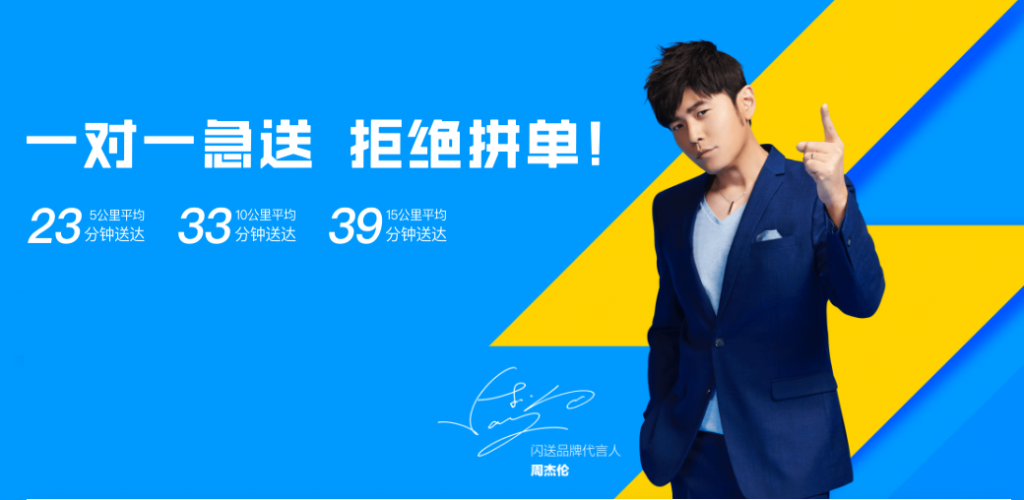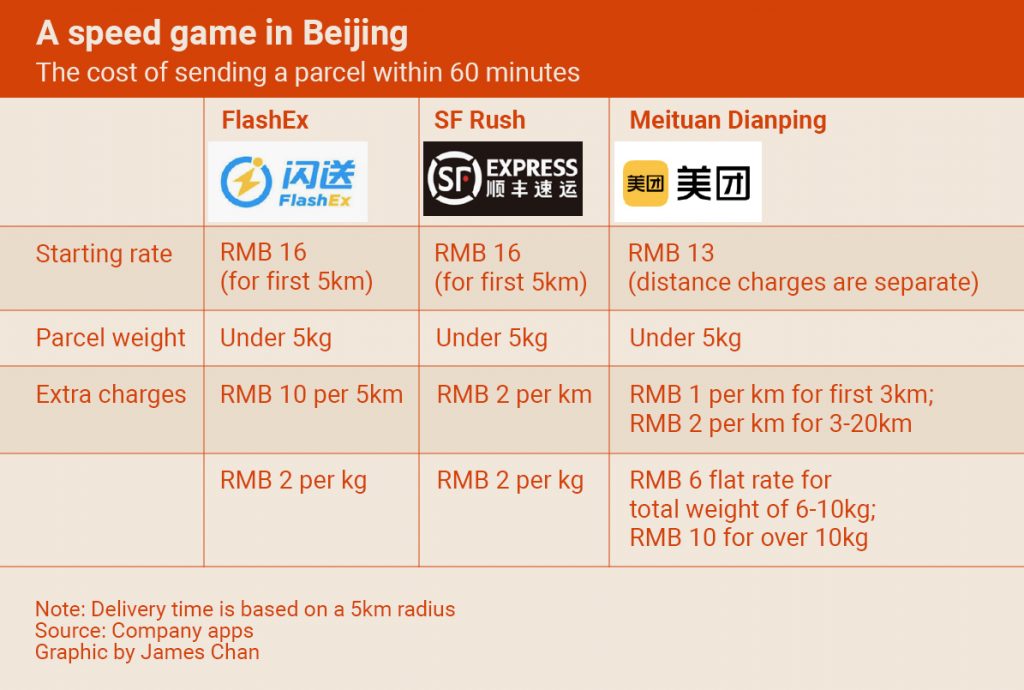Featuring famous Taiwan’s pop singer Jay Chou, advertisements of FlashEx have recently been plastered across residences’ elevators to subway tunnels in cities such as Beijing and Shanghai.
FlashEx, or Shansong Express in Chinese (which means “flash delivery”), is an express courier that delivers everything from flowers, cakes to personal IDs within a city. It claims to complete a task at an average of 23 minutes within a radius of 5 kilometers, and 39 minutes within 15km.
The company, launched in 2014, is not alone in tapping this fast-growing market.
As many as 11.4 billion express deliveries were completed in China in 2018, up 23% from the previous year, according to the State Post Bureau, which regulates the country’s postal service provider China Post. That translates to a market worth RMB 90.5 billion (USD 12.7 billion).
Traditional courier companies started to offer intra-city express deliveries only in 2017. SF Express, for instance, offers a wide range of services that include same-day delivery to 30-minute rush delivery within a 3km radius.
Not to be outdone, Meituan Dianping, China’s largest on-demand services platform, tapped its takeout delivery fleet in March 2017 to offer intra-city parcel delivery service too. Main rival Ele.me followed suit a month later.
E-commerce giant JD.com also joined in the fray in October 2018. The company kicked off a courier service that transports parcels within two days in the same city, before providing a 30-minute rush delivery in April.

FlashEx, which joined the unicorn club in August last year, has more than 700,000 registered riders and over 100 million customers, according to its website. It boasted as the fastest intra-city express courier in Southeast Asia—within 60 minutes—with offices in Singapore and Malaysia.
The company, whose services are available in over 220 Chinese cities, last year moved into smaller third- and fourth-tier cities. The latter now contributed to more than 30% of its total orders, co-founder Yu Hongjian told 36Kr in a recent interview. He said FlashEx isn’t fazed by the intense competition thanks to its round-the-clock services and price competitiveness. Yu also said the company doesn’t have plans to branch into other sectors like what its rivals are stepping into his territory.
Below is an edited excerpt of the interview.
36Kr (Kr): As one of the earliest entrants into the field, FlashEx recently changed its tagline to “one-on-one services,” and hired Jay Chou as a brand ambassador. What do you hope to achieve?
Yu: We would like to emphasize on “one-on-one” and “no group delivery” for this campaign. For express couriers, it is very common for one to take on several orders at the same time to lower the cost per delivery. But for FlashEx, we are doing high-end deliveries with each FlashRider taking only one order at a time. [Editor’s note: FlashEx dubs its rider as “FlashRider.”]
Speed is no longer the only factor to win businesses in the express logistics industry. Instead, people may choose one service provider over another based on their own experience and recognition of certain brands. Taking one order at a time will ensure our customers receive better user experiences.
Let me give you an example. A customer accidentally forgot to bring his passport after he arrived at the airport. He quickly placed an order on our app, and a FlashRider managed to transport his passport in time, saving the customer from missing his flight.
We once received an order from a CEO of a big internet company, who would like to have an urgent document delivered in no more than 30 minutes. While our Flashrider wasn’t obligated to do so, he fulfilled the request without violating traffic rules. If our FlashRiders took several orders at the same time, they would never be able to offer such personalized and “one-on-one” services.
Kr: Will the cost per delivery increase as a result of this “one-on-one” service? Does it mean users have to pay more?
Yu: I don’t think so. The best proof is that the starting rate for FlashEx in Beijing has actually decreased from RMB 36 (USD 5.1) to RMB 16. For FlashRiders, they earn 80% per order as a commission. Despite a lower starting rate, the volume of orders is increasing, and this offers our FlashRiders a stable income source. This business model will attract more people to join us as a FlashRider. With more people joining our fleet to cope with the expected surge in demand, we’ll be able to lower the cost per delivery and enhance price competitiveness for our customers.

Kr: More players such as those in the food delivery and traditional courier services have stepped into your turf. How do you differentiate FlashEx from the competition?
Yu: I don’t think those industries you mentioned can be able to grab a bite of the growing pie, as they are different in nature from us. For those in the food delivery business, their service radius ranges from 1.5–3km, covering a relatively fixed neighborhood. However, our FlashRiders deliver packages across the whole city. In addition to electric scooters, they use cars and motorbikes, and our services are 24×7. That differentiates us.
Some people started to use our service for emergency deliveries, but have turned into a loyal customer. With a starting rate of RMB 16 in Beijing, they usually pay an average of RMB 30 per order. Customers may find that using FlashEx will cost them basically the same as that provided by the same-day delivery courier—but we are faster.
Plus, customers will be assigned a specific FlashRider to take care of their packages with a guaranteed delivery time within a designated distance radius. Based on these advantages, people will gradually turn to FlashEx for more types of deliveries other than emergency packages.
Kr: Do you plan to diversify into other businesses other than courier?
Yu: We plan to focus on our core strength over the next three to five years, because we think there is more we could do for our current business.
Yes, speed is a prerequisite in the courier industry, but we want to improve service quality by paying attention to details. For example, we have our own designed package boxes for cakes. That will ensure the cakes are still in one piece if there is a minor collision happening during the commute. We are also fine-tuning our estimated pickup and delivery time system, because time matters to most people.
For individuals, convenience is what they are after. What if you have purchased a car online and want it delivered to your doorsteps? And we can have all the paperwork filled up before handing you the car key personally?
For enterprise clients, they want nothing but efficiency. Let’s say a startup has finally sealed a deal with the investors. The company may want to tap our service to pick up the envelop and get all stamps and signatures from every party involved. It no longer needs to send the papers to different parties, and deal with the back and forth.
Also, perhaps a restaurant can just simply have a central kitchen and gets rid of its restaurant outlets. With FlashEx, we can do the pickups from the kitchen and bring the meals to diners across the city.
In short, we are not concerned about our future growth. We want to focus on doing what we do now and make them better.
The original article was written by Tang Jiamin of 36Kr, KrASIA’s parent company.
Contact the writer at [email protected]
